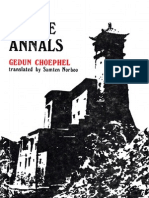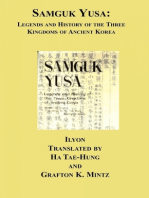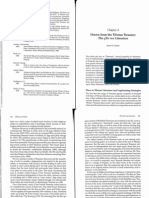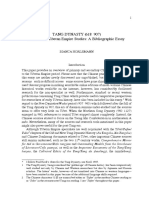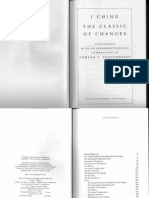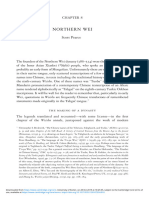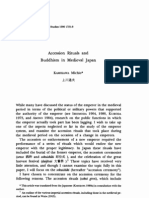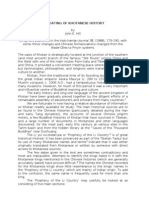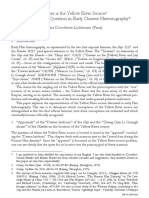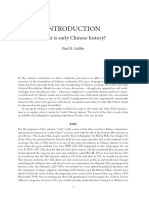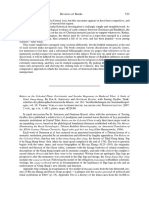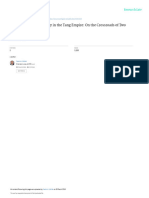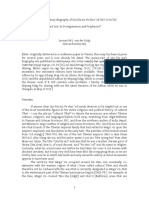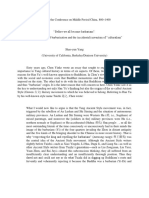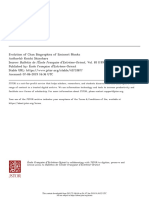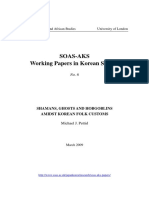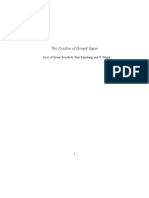Buddha Relic 9 TH Century China
Buddha Relic 9 TH Century China
Uploaded by
srimahakalaCopyright:
Available Formats
Buddha Relic 9 TH Century China
Buddha Relic 9 TH Century China
Uploaded by
srimahakalaOriginal Title
Copyright
Available Formats
Share this document
Did you find this document useful?
Is this content inappropriate?
Copyright:
Available Formats
Buddha Relic 9 TH Century China
Buddha Relic 9 TH Century China
Uploaded by
srimahakalaCopyright:
Available Formats
Was there an imperial distribution of Buddha relics in ninth-century China?
T. H. BARRETT
School of Oriental and African Studies
Chinese imperial attempts at increasing the prestige of a regime by emulating the legendary Ashokan feat of distributing 84,000 relics of the Buddha at one time across the whole world have attracted some attention in recent years. We know now that one important relic distribution took place at the start of the seventh century, and another at the end.1 A tenth-century distribution by a king whose domain encompassed the lower Yangtse area has also been studied, not simply for its religious and political symbolism but also as part of the early history of printing. This is because the Buddhas relics and the Buddhas word were seen as in some respects equivalent, and printing offered an excellent way of achieving the target of productivity suggested by legend, in that short printed texts could be substituted for relics themselves.2 In Japan just such a move seems to have resulted already in the late eighth century in the creation of some of the oldest printed materials to survive to this day.3 In commenting on this sequence of distributions recently, I noted on the basis of a fourteenth-century document cited in a secondary source some indications of another possible distribution of Buddhist relics in the mid-ninth century, facilitated perhaps by the centralization of existing Buddha relics in China by the state as part of the great Huichang persecution of 84045.4 This source, by the historian and lay Buddhist scholar Song Lian (1310 82), was an inscription for the Ashoka Monastery in Zhejiang, as preserved in the nineteenth-century provincial gazetteer for the region.5 This in turn no doubt derived from a 1619 gazetteer for the monastery itself, modern reprints of which derive from a second edition of circa 1758.6 The author of the piece, Song Lian, whose inscription dates to 1378, has not, however, won a particularly distinguished reputation as a historian. The dynastic history of the Mongol period that he edited is generally regarded as a fairly sloppy piece of work, while his own historical writing seems to wander at times from the path of objectivity.7 It is worth noting therefore that the tale he tells is clearly not his
1 The best work on these events may be found in Chen Jinhua, Monks and Monarchs, Kinship and Kingship (Kyoto: Italian School of East Asian Studies, 2002) ch. 2 and 3. 2 On the tenth-century episode, see p. 36 of Edmund H. Worthy, Jr., Diplomacy for survival: domestic and foreign relations of Wu Yeh, 907978, in Morris Rossabi (ed.), China Among Equals (Berkeley and Los Angeles: University of California Press, 1983), pp. 744. On its significance for printing, see Tsien Tsuen-hsuin, Science and Civilisation in China, Vol. V.1 (Cambridge: Cambridge University Press, 1985), pp. 578. 3 What we know of this event has been succinctly summarized by P. F. Kornicki, The Book in Japan: A Cultural History from the Beginnings to the Nineteenth Century (Leiden: E. J. Brill, 1998), pp. 11417. 4 See p. 55 of T. H. Barrett, Stu r pa, su r tra, and s aarira in China, c. 656706 CE, Buddhist Studies Review 18/1, 2001, pp. 164. 5 Wang Yunwu (ed.), Zhejiang tongzhi 230 (Shanghai: Shangwu, 1934, indexed reprint of 1899), pp. 39245. 6 For this work and its reprints, see Timothy Brook, Geographical Sources of MingQing History, second edition (Ann Arbor: Center for Chinese Studies, The University of Michigan, 2002), p. 181: I have used the facsimile edition from the 1996 Zhongguo fosi zhi congkan series listed there, in which Songs remarks on the events concerned may be found on p. 4B.2a. 7 For Songs shortcomings as an editor, see the remarks of Frederick Mote, in Herbert Franke and Denis Twitchett (eds), The Cambridge History of China, Volume 6: Alien Regimes and Border States (Cambridge: Cambridge University Press, 1994), pp. 68993; for a study of a document from his own hand, see pp. 6873 of Hok-Lam Chan, Chang Chung and his prophecy: the transmission of the legend of an early Ming Taoist, Oriens Extremus 20/1, 1973, pp. 65102.
Bulletin of SOAS, 68, 3 (2005), 451454. School of Oriental and African Studies. Printed in the United Kingdom.
452
T. H. BARRETT
alone, but may earlier be found with the precise date 850 in an account of the monastery written in 1355 by an otherwise obscure monk, Wuguang, also to be found in the 1628 gazetteer, though so far I know of no complete source older than that, even if (as we shall see) one may have existed.8 The monastery derived its name from a famous reliquary, supposedly deriving from the legendary distribution of the Indian ruler, which had originally been rediscovered on Chinese soil according to local lore by Liu Sahe, a renowned detector of hidden Buddhist relics said variously to have lived in the third, fourth or fifth century CE.9 This reliquary, already famous in early Tang times, had been confiscated during the Huichang persecution and placed in a nearby government office.10 During the subsequent reign of the emperor Xuanzong (846859) it had been reassigned to an officially supported Kaiyuan Monastery, only to be returned to its original home after popular protests. Now this in itself suggests no more than a mere expedient redistribution of existing sacred objects, not a deliberate campaign involving the simultaneous dissemination of a large number of relics. But however late our sources for this specific event, it would appear to be at least prima facie quite conceivable that the Huichang persecution brought a great many such objects into the hands of the imperial government, and so we might reasonably expect some ideological use to have been made of the resulting opportunity. The topic does therefore demand a review of whatever evidence is still available. Chinese official sources however, while noting the revival of imperial support for Buddhism, reveal nothing useful on this score, and while surviving inscriptions of the period confirm the historians picture of the emperors enthusiasm for the religion, I have found so far none that describes the dissemination of relics.11 One might have hoped that Dunhuang, at this point recently returned to the Chinese fold by a local military leader after a period of Tibetan domination, would have preserved some record of having received a relic. There was a prominent local cleric there who certainly did receive an imperial ordination certificate at this time, according to an inscription unearthed there in the early twentieth century, but though this source suggests that other donations were simultaneously made to reward the clerics local commander, no specific mention is made of any relic of the Buddha, or indeed of any religious items at all as forming part of the imperial largesse.12 The life of this clerics chief disciple, tooa disciple who was much involved in integrating his community back into the larger Chinese Buddhist worldhas been studied at some length through the surviving documents, and here, likewise, while it is clear that he received his due reward in presents, relics seem never to be mentioned.13 What is more,
8 Ayushan zhi 2.3a; cf. pp. 6.2b3a, where the events are recapitulated in a lengthier narrative presumably composed by the seventeenth-century editor. 9 For Liu Sahe, see inter alia Hlne Vetch, Lieou Sa-ho et les grottes de Mo-kao, in M. Soymi (ed.), Nouvelles Contributions aux tudes de Touen-houang (Geneva: Librarie Droz, 1981), pp. 13748; Sun Xiushen, Liu Sahe heshang shiji kao, in Dunhuang Wenwu yanjiusuo (ed.), 1983 nian Quanguo Dunhuang Xueshu Taolunhui Wenji: shiku, yishu bian, shang (Lanzhou: Gansu Renmin chubanshe, 1985), pp. 272310; and pp. 50710 of E. G. Pulleyblank, Ji Hu: indigenous inhabitants of Shaanbei and western Shanxi, in E. H. Kaplan and D. W. Whisenhunt (eds), Opuscula Altaica: Essays Presented in Honor of Henry Schwartz (Bellingham: University of Western Washington, 1994), pp. 499531. 10 The earliest legends concerning the reliquary up to the late seventh century are covered by Daoshi, Ji Shenzhou sanbao gantong lu 1, pp. 404b405b, in the edition of the Taisho Canon, vol. 52. 11 See e.g. Sima Guang, Zizhi tongjian 249 (Hong Kong: Zhonghua shuju, 1976 reprint), pp. 80478, for Xuanzongs efforts at reviving Buddhism, and some consequent complaints from his officials. 12 This inscription is reprinted in Jiang Liangfu, Mogaoku nianbiao (Shanghai: Shanghai guji chubanshe, 1985), pp. 3923. 13 Chen Tsu-lung, La vie et les oeuvres de Wou-tchen (816895) (Paris: EFEO, 1966), pp. 2544, covers the period in question; p. 35 mentions presents, unspecified.
WAS THERE AN IMPERIAL DISTRIBUTION
453
a true imperial relic distribution should have involvedto judge by the pattern of those for which we have more informationthe dispatch of some relics overseas to such places as Japan, but there is not, so far as I am aware, any record of this in Japanese sources, though admittedly these seem not to depict Japan as either asking for or receiving Chinese imperial donations, even where we know that this happened from other materials.14 Korean historians apparently suffered from no such scruples, and the thirteenth-century Samguk yusa, our main Buddhist source for the history of the period, is particularly interested in relics of continental origin.15 For the reign of Xuanzong, moreover, that work first notes that an official envoy to the Tang court, Won Hong, brought back a Buddha tooth, and later in the text that he also brought back scriptures, both under the date 851.16 And the slightly fuller information on this event in the earlier Samguk sagi, compiled by the Confucian scholar Kim Pu-sik (10751151) in 1145, unambiguously conjoins the two events. Here, under the year 851, we read that Won brought back both scriptures and a Buddhas tooth together, and also that the King, Munso h ng (r. 839857), as a sign of reverence, came out to the suburbs to meet him.17 But is this enough evidence from which to conclude that a concerted relic distribution campaign actually did take place? Taking into consideration the general pattern of silence in the surviving documentation, probably not. The reluctance or negligence of some of our sources in discussing such matters is easy enough to understand: few authors, except for those promoting Buddhism, were particularly interested in preserving a full record of imperial support for the religion. In the case of the Empress Wu, moreover, scholars like Antonino Forte have shown that the enthusiastic support of the Buddhist community for her usurpation later necessitated a considerable rewriting of history after the restoration of the Tang dynastic line, so even Buddhist writers tend to be rather restrained in their coverage of the period.18 We know of her relic campaign, therefore, only due to one obscure provincial inscription and a Tang period manuscript rediscovered in the twentieth century.19 But the main Buddhist chronicle for later times, the Fozu tongji, compiled by Zhipan in 1269, does record the earlier relic distribution campaign, and does record the later, tenth century, printed relic distribution.20 The joyful return of the reliquary to its original place in the Ashoka Monastery is also listed, under the year 849, but it is not related in any way to any broader activity.21 Nor is it likely that this lack of any mention of a wider context was due to a shortage of materials. Official sources for the late Tang are less than ideal,
14 The official record may be found in Charlotte von Verschuer, Les Relations Officielles du Japon avec la Chine aux VIIIe et IXe Sicles (Geneva and Paris: Librarie Droz, 1985), Deuxime Partie, which provides a chronicle derived from the basic sources. For a Japanese request known only from the Chinese side, see pp. 1718 and n. 13 of T. H. Barrett, Shinto and Taoism in early Japan, in John Breen and Mark Teeuwen (eds), Shinto in History: Ways of the Kami (Richmond: Curzon, 2000), pp. 1331. 15 The compiler, Ilyon, devotes a lengthy section of his work to such imports, available in English translation in Ha Tae-Hung and Grafton K. Mintz, Samguk yusa: Legends and History of the Three Kingdoms of Ancient Korea (Seoul: Yonsei University Press, 1972), pp. 22434. 16 Ilyon, Samguk yusa 3, pp. 992b24, 993b2 (in Taisho Canon, vol. 49); cf. Ha and Mintz, Samguk yusa, pp. 226, 231. 17 Lee Kang-lae (ed.), Kim Pu-sik, Samguk sagi 11 (Seoul: Hangilsa, 1998), p. 156. I am grateful to my former student, Dr J. Seo, for the gift of a copy of this useful variorum edition. 18 For some examples of the historiographical consequences for Buddhists, see T. H. Barrett , The date of the Leng-chia shih-tzu chi, Journal of the Royal Asiatic Society, third series 1/2 (July 1991), pp. 2559. 19 We therefore owe our knowledge of this event largely to the assiduity of Chen Jinhua in tracking down the requisite information: see his Monks and Monarchs, pp. 1235, 1278. 20 Zhipan, Fozu tongji 39, p. 361a1415, 44, p. 394c2427, in edition of Taisho Canon, vol. 49. 21 Zhipan, Fozu tongji 42, p. 387a1517.
454
T. H. BARRETT
but Buddhist writers of the next few centuries had, for example, a fairly abundant supply of late Tang epigraphical information at their disposal and generally made good use of itthe story of the return of the reliquary from the Kaiyuan Temple to its original place may indeed ultimately derive from such a source. But if there really was any information concerning a concerted campaign of relic distribution at this time, is highly likely to have been recorded somewhere in at least one other simultaneous inscription, and so to have entered the Chinese Buddhist historiographical tradition of later times, even if the full text versions of some inscriptions were subsequently lost. Even so, the Korean references do help to show that in a broader sense the tradition of the political use of relics remained unbroken, and that the association between relics and scriptures in this context was also one that persisted for centuries, and was not just a feature of one particular period.
You might also like
- Gedun Choephel - The White AnnalsDocument106 pagesGedun Choephel - The White Annalsbergalm00100% (3)
- Korean LiteratureDocument28 pagesKorean LiteratureAlicegrace Gals100% (1)
- Edward Shaughnessy - I Ching - The Classic of Changes - (Poor OCR) (179pp)Document179 pagesEdward Shaughnessy - I Ching - The Classic of Changes - (Poor OCR) (179pp)voraciousreaderII100% (2)
- Myth, Memory and Reinvention in Korea: The Case of Tan'Gun Michael J. Seth James Madison UniversityDocument13 pagesMyth, Memory and Reinvention in Korea: The Case of Tan'Gun Michael J. Seth James Madison Universityqloria100% (1)
- China and The Chinese - Book of Chinese Poetry PDFDocument580 pagesChina and The Chinese - Book of Chinese Poetry PDFJames100% (1)
- An Ancient Chinese Treatise On AlchemyDocument85 pagesAn Ancient Chinese Treatise On AlchemyPriyanka Mokkapati100% (1)
- An Exploratory Study of The Effects of Practicing Tibetan Dream Yoga Four Foundations On Waking Life Awareness and DreamsDocument240 pagesAn Exploratory Study of The Effects of Practicing Tibetan Dream Yoga Four Foundations On Waking Life Awareness and Dreamssrimahakala100% (1)
- Introduction To Classical Korean Literature: From Hyangga To P'ansoriDocument26 pagesIntroduction To Classical Korean Literature: From Hyangga To P'ansoriHeianYi0% (1)
- Barrett ImperialdistributionBuddharelicsChina BSOS 68-3-2005Document4 pagesBarrett ImperialdistributionBuddharelicsChina BSOS 68-3-2005srimahakalaNo ratings yet
- Kung-Sun Lung TzuDocument35 pagesKung-Sun Lung TzuPriyanka Mokkapati100% (1)
- Monsters and Magical Sticks - There's No Such Thing As HypnosisDocument22 pagesMonsters and Magical Sticks - There's No Such Thing As Hypnosismaxalves77No ratings yet
- Records of the Transmission of the Lamp: Volume 7 (Books 27-28) Biographies and Extended DiscoursesFrom EverandRecords of the Transmission of the Lamp: Volume 7 (Books 27-28) Biographies and Extended DiscoursesNo ratings yet
- Van Schaik and L. Doney An Early Buddhist Narrative From DunhuangDocument47 pagesVan Schaik and L. Doney An Early Buddhist Narrative From DunhuangAnthony TribeNo ratings yet
- Chinghis KhanDocument2 pagesChinghis KhanadimarinNo ratings yet
- Solonin - 2020 - Local Literatures - Tangut - Xixia - BrillDocument25 pagesSolonin - 2020 - Local Literatures - Tangut - Xixia - BrillPaolo VisigalliNo ratings yet
- On The Origin of Tibetan Writing PDFDocument14 pagesOn The Origin of Tibetan Writing PDFalexiselisandroNo ratings yet
- Lin Ying 2007 Fulin Monks POC 57 (2007) 24-42Document10 pagesLin Ying 2007 Fulin Monks POC 57 (2007) 24-42高橋 英海No ratings yet
- Am Vol 192006 Boucher Dharma Rak S ADocument25 pagesAm Vol 192006 Boucher Dharma Rak S AsrimahakalaNo ratings yet
- Jiabs 16-2Document170 pagesJiabs 16-2JIABSonline100% (1)
- 8.drawn From The Tibetan Treasury The Gter Ma LiteratureDocument12 pages8.drawn From The Tibetan Treasury The Gter Ma LiteraturenewianuNo ratings yet
- Mongol Pilgrimages To Wutaishan in The LDocument55 pagesMongol Pilgrimages To Wutaishan in The Lc_mosNo ratings yet
- 75462-Hill-Notes On The Dating of Khotanese History-A013Document13 pages75462-Hill-Notes On The Dating of Khotanese History-A013Rodrigo Méndez LópezNo ratings yet
- JRAS XII Early History of TibetDocument118 pagesJRAS XII Early History of TibetdavebeaNo ratings yet
- Origin of Tibetan ScriptDocument14 pagesOrigin of Tibetan ScriptDarie NicolaeNo ratings yet
- Kukai's Epitaph For Master Huiguo - An Introduction and Translation PDFDocument26 pagesKukai's Epitaph For Master Huiguo - An Introduction and Translation PDFLukeNo ratings yet
- Records of the Transmission of the Lamp (Jingde Chuandeng Lu): Volume 8 (Books 29&30) – Chan Poetry and InscriptionsFrom EverandRecords of the Transmission of the Lamp (Jingde Chuandeng Lu): Volume 8 (Books 29&30) – Chan Poetry and InscriptionsNo ratings yet
- Unearthing the Changes: Recently Discovered Manuscripts of the Yi Jing ( I Ching) and Related TextsFrom EverandUnearthing the Changes: Recently Discovered Manuscripts of the Yi Jing ( I Ching) and Related TextsNo ratings yet
- Review by Elliot Sperling - Central Tibet and The Mongols - The Yüan-Sa-skya Period of Tibetan History by Luciano PetechDocument3 pagesReview by Elliot Sperling - Central Tibet and The Mongols - The Yüan-Sa-skya Period of Tibetan History by Luciano Petechkabul87No ratings yet
- Xia DynastyDocument6 pagesXia DynastycorneliuskooNo ratings yet
- Tang Dynasty 618 907 Sources For TibetanDocument34 pagesTang Dynasty 618 907 Sources For TibetanEnes AdıgüzelNo ratings yet
- Chinese Sources On South AsiaDocument22 pagesChinese Sources On South AsiamarcelogicasNo ratings yet
- I Ching - SCAN (179pp)Document179 pagesI Ching - SCAN (179pp)mrot100% (7)
- Northern WeiDocument29 pagesNorthern WeiDavid SlobadanNo ratings yet
- The Shang and Zhou Dynasties of AncientDocument10 pagesThe Shang and Zhou Dynasties of AncientAqil ElbannaNo ratings yet
- Solonin SiniticBuddhismTangut 2014Document28 pagesSolonin SiniticBuddhismTangut 2014gréalNo ratings yet
- Power, Politics and The Reinvention of Tradition - Tibet in The Seventeen and Eighteenth CenturiesDocument214 pagesPower, Politics and The Reinvention of Tradition - Tibet in The Seventeen and Eighteenth CenturiesLászló Uherkovich100% (7)
- Accession Rituals and Buddhism in Medieval JapanDocument38 pagesAccession Rituals and Buddhism in Medieval JapanKatanabiNo ratings yet
- 8.2008 Blood Covenant Final English PROOFDocument64 pages8.2008 Blood Covenant Final English PROOFDavy Tong100% (1)
- Spring and Autumn Annals of Wu and Yue: An Annotated Translation of Wu Yue ChunqiuFrom EverandSpring and Autumn Annals of Wu and Yue: An Annotated Translation of Wu Yue ChunqiuRating: 5 out of 5 stars5/5 (1)
- Yixing and Pseudo-YixingDocument37 pagesYixing and Pseudo-Yixingc_mc2No ratings yet
- 01_Kim_Religious_and_Philosophical_2019Document5 pages01_Kim_Religious_and_Philosophical_2019tkdhienNo ratings yet
- Tangun Foundation Myth KCDocument11 pagesTangun Foundation Myth KCZeinaNo ratings yet
- The_Historical_Authenticity_of_Early_BudDocument36 pagesThe_Historical_Authenticity_of_Early_BudmightyjafoolNo ratings yet
- Chinese Historiography and Music Some ObservationsDocument23 pagesChinese Historiography and Music Some ObservationsbamboomonkeyNo ratings yet
- REVIEW - Li Feng. Early China A Social and Cultural History (McConochie, Thomas)Document3 pagesREVIEW - Li Feng. Early China A Social and Cultural History (McConochie, Thomas)A808No ratings yet
- On The Authenticity of The Bamboo AnnalsDocument32 pagesOn The Authenticity of The Bamboo AnnalsEzgamApeNo ratings yet
- Types and Values of Bhutanese LiteratureDocument18 pagesTypes and Values of Bhutanese LiteratureLobzang DorjiNo ratings yet
- Nepalese Buddhist Artist Arniko and His Contribution To Buddhist Heritage of ChinaDocument14 pagesNepalese Buddhist Artist Arniko and His Contribution To Buddhist Heritage of ChinaMin Bahadur shakya100% (1)
- Preface by Chögyal Namkhai NorbuDocument4 pagesPreface by Chögyal Namkhai NorbudogenvNo ratings yet
- KHOTAN - Revised Times Ext Roman FontDocument14 pagesKHOTAN - Revised Times Ext Roman FontJohn HillNo ratings yet
- Where Is The Yellow River Source? A Controversial Question in Early Chinese HistoriographyDocument23 pagesWhere Is The Yellow River Source? A Controversial Question in Early Chinese HistoriographyDavid SlobadanNo ratings yet
- What Is Early Chinese History (Article) Author Paul R GoldinDocument11 pagesWhat Is Early Chinese History (Article) Author Paul R GoldinStefan SofricNo ratings yet
- Review On Rulers On The Celestial Plain. Ecclesiastic and Secular HegemonyDocument4 pagesReview On Rulers On The Celestial Plain. Ecclesiastic and Secular HegemonyJigdrel77No ratings yet
- Chinese LiteratureDocument15 pagesChinese LiteratureAdrian VelázquezNo ratings yet
- Symbols of The Huns in Central AsiaDocument7 pagesSymbols of The Huns in Central AsiaEstefaniaNo ratings yet
- Early Chinese Christianity in The Tang EmpireDocument26 pagesEarly Chinese Christianity in The Tang EmpireQuang NguyenNo ratings yet
- A Fifteenth Century Biography of Lha BlaDocument47 pagesA Fifteenth Century Biography of Lha BlaGábor FülöpNo ratings yet
- Shao Yun ShangDocument41 pagesShao Yun ShangusfetcNo ratings yet
- École Française d'Extrême-Orient Bulletin de L'école Française d'Extrême-OrientDocument21 pagesÉcole Française d'Extrême-Orient Bulletin de L'école Française d'Extrême-OrientDylan PlungNo ratings yet
- 2016e Before A Critical Edition of The SDocument26 pages2016e Before A Critical Edition of The SCTSNo ratings yet
- Chinese Literature by Jerid XDDocument283 pagesChinese Literature by Jerid XDJerid Aisen FragioNo ratings yet
- Machik LapronDocument6 pagesMachik LapronDanila 'buural'No ratings yet
- A Study of Yogacara Theory of The Ten CausesDocument285 pagesA Study of Yogacara Theory of The Ten Causessrimahakala100% (1)
- Compassion in The Tibetan Book of The Dead and The Tractate Mourning - A Comparative StudyDocument126 pagesCompassion in The Tibetan Book of The Dead and The Tractate Mourning - A Comparative StudysrimahakalaNo ratings yet
- Manchu Tibetan Relations in The Early Seventeenth Century, A ReappraisalDocument215 pagesManchu Tibetan Relations in The Early Seventeenth Century, A ReappraisalsrimahakalaNo ratings yet
- D1402 (Mngon Par Brjod Pa 'Bum Pa Las Phyung Ba Nyung Ngu'i Rgyud Kyi Bsdus Pa'i Don Rnam Par Bshad PaDocument15 pagesD1402 (Mngon Par Brjod Pa 'Bum Pa Las Phyung Ba Nyung Ngu'i Rgyud Kyi Bsdus Pa'i Don Rnam Par Bshad PasrimahakalaNo ratings yet
- Penetrating The Secret Essence TantraDocument612 pagesPenetrating The Secret Essence Tantraaurora7755100% (4)
- Genesis and Development of Tantrism - Edited by Shingo EinooDocument562 pagesGenesis and Development of Tantrism - Edited by Shingo Einooindology2100% (3)
- Space, Time and Anu in VaisheshikaDocument16 pagesSpace, Time and Anu in VaisheshikasrimahakalaNo ratings yet
- Ja Nanda: Search Words: Jay NandaDocument4 pagesJa Nanda: Search Words: Jay NandasrimahakalaNo ratings yet
- A ThousandDocument1 pageA ThousandsrimahakalaNo ratings yet
- The Religious Career of Vairocanavajra-A Twelfth-Century Indian Buddhist Master From Daksina Ko - AlaDocument24 pagesThe Religious Career of Vairocanavajra-A Twelfth-Century Indian Buddhist Master From Daksina Ko - AlasrimahakalaNo ratings yet
- BUD Sheehy Jonang FINAL PJ To Author MRSDocument13 pagesBUD Sheehy Jonang FINAL PJ To Author MRSsrimahakalaNo ratings yet
- Space, Time and Anu in VaisheshikaDocument16 pagesSpace, Time and Anu in VaisheshikasrimahakalaNo ratings yet
- A Complete Catalogue of Sakya Lam'Bras Literature SeriesDocument26 pagesA Complete Catalogue of Sakya Lam'Bras Literature SeriessrimahakalaNo ratings yet
- Iconography of Amoghpasa LokeshvaraDocument6 pagesIconography of Amoghpasa LokeshvarasrimahakalaNo ratings yet
- Yantra - Wikipedia, The Free EncyclopediaDocument4 pagesYantra - Wikipedia, The Free EncyclopediasrimahakalaNo ratings yet
- Tokyo-7-Directory v1 m56577569830510952Document0 pagesTokyo-7-Directory v1 m56577569830510952srimahakalaNo ratings yet
- Tang Taoism and The Mention of Jesus and Mani in Tibetan Zena Comment On Recent Work by Rong XinjiangDocument3 pagesTang Taoism and The Mention of Jesus and Mani in Tibetan Zena Comment On Recent Work by Rong XinjiangsrimahakalaNo ratings yet
- Tokyo 7 ContentsDocument2 pagesTokyo 7 ContentssrimahakalaNo ratings yet
- Tokyo-7-Sleeping v1 m56577569830510958Document0 pagesTokyo-7-Sleeping v1 m56577569830510958srimahakalaNo ratings yet
- A Tibetan Aristocratic Family in Eighteenth-Century Tibet A Study of Qing-Tibetan Contact (China) .Document338 pagesA Tibetan Aristocratic Family in Eighteenth-Century Tibet A Study of Qing-Tibetan Contact (China) .srimahakalaNo ratings yet
- Shamans GhostDocument15 pagesShamans GhostYam YamNo ratings yet
- Best, Jonathan, A History of The Early Korean Kingdom of PaekcheDocument584 pagesBest, Jonathan, A History of The Early Korean Kingdom of PaekcheChâu VũNo ratings yet
- Allan Marett - Musica Asiatica 6-Cambridge University Press (1991) PDFDocument144 pagesAllan Marett - Musica Asiatica 6-Cambridge University Press (1991) PDFVincenzo PescatoreNo ratings yet
- Biographies of Underprivileged in the Samguk sagi (三國史記) Chronicle Miriam Löwensteinová, Charles University in Prague, Czech RepublicDocument11 pagesBiographies of Underprivileged in the Samguk sagi (三國史記) Chronicle Miriam Löwensteinová, Charles University in Prague, Czech RepublicDejana VučinićNo ratings yet
- Queen SeondeokDocument91 pagesQueen SeondeokStavrogin1881No ratings yet
- Korean Literature-MACASDocument18 pagesKorean Literature-MACASShay AntazoNo ratings yet
- Korean History Midterm Review SheetDocument30 pagesKorean History Midterm Review Sheetsweetchickxp1No ratings yet
